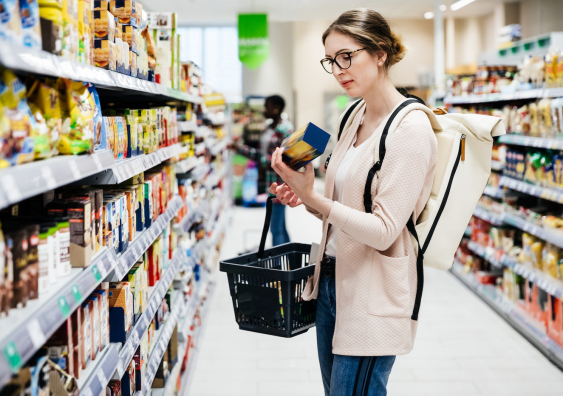Online grocery shopping: 'huge gap' in major supermarkets' food labelling
Nearly all food products in the online stores of Coles and Woolworths lack complete food product labels, research finds.
Nearly all food products in the online stores of Coles and Woolworths lack complete food product labels, research finds.

Ben Knight
UNSW Media & Content
(02) 9065 4915
b.knight@unsw.edu.au
Food label information that is otherwise mandatory for physical products is missing from online supermarkets in Australia, which may pose a health and safety risk for consumers, a new study suggests.
Analysis of more than 22,000 products from the online stores of the two leading supermarket retailers, Coles and Woolworths, found almost all lack at least some crucial product information, including ingredient lists and allergy warnings. The study, published today in the , is the first to assess the completeness of food labelling in online supermarkets in Australia, and highlights the need for current regulations to include these settings so online shoppers can make informed choices.
Food product labels are required for product packaging in physical stores. Nutrition information panels (NIPs), ingredient lists and allergen declarations are requirements under Food Standards Australia New Zealand, while the ACCC also requires country-of-origin labelling. Health Star Ratings (HSRs), which aim to provide a quick and easy summary of product healthiness, can also be voluntarily displayed. However, online stores are not explicitly obligated to meet any labelling standards despite considerable growth in the market.
“Traditionally, shoppers could simply pick up a product to find relevant information. However, there are no requirements to provide the same information to online shoppers before they decide to commit their cash,” says , lead author of the study and a PhD Candidate in food policy at and UNSW Medicine & Health. “It’s not surprising to see a huge gap in how the major supermarkets provide product information in their online grocery stores, which might not be deliberate or malicious but does fail to help people with choosing products that meet their dietary or health needs.”
Missing or difficult-to-find information about food products is not just an issue for consumer choice – it also poses potentially significant concerns. Ingredients and allergen information are critical to protect consumers with allergies, while NIPs and HSRs are also crucial tools to contribute towards reducing the risk of major chronic diseases like heart attacks and diabetes.
“For consumers, the lack of available and easy-to-access product information in online stores can pose immediate and long-term health and safety risks,” says , senior author of the study and head of the Nutrition Science program at The George Institute for Global Health and UNSW Medicine & Health. “Our findings highlight the need to strengthen labelling requirements for the online retail food environment.”
For the study, researchers analysed the food products available online from the two leading supermarket retailers in Australia from April–May 2022 to determine the prevalence of product information and voluntary HSR labels.
They found product information is mostly lacking in online supermarkets. Only around half of all food products had allergen labelling (53 per cent) and NIPs (49 per cent), while just over a third (34 per cent) had ingredients listed. However, country-of-origin labelling was comprehensive, appearing on 93 per cent of food product pages, despite being a more recent requirement.

Food product labels are required for product packaging in physical stores. Photo: Getty Images.
Though both retailers have previously demonstrated a commitment to providing HSRs for all their home brand products in store, their display online was lacking, particularly for Coles. HSRs were infrequently displayed, appearing on just 14 per cent of products across both supermarkets overall. They were also more likely to be present for higher-scoring products, appearing on 22 per cent of products that score 3.5 stars or higher, compared to just 0.4 per cent of products that receive less than 3.5 stars.
“HSRs, which are intended as an easy-to-use guide to the overall healthiness of a product, are rarely made available, and there was evidence of their selective application to higher scoring products,” Mr Maganja says. “The almost complete display of country-of-origin labelling, coupled with the differential application of HSRs, may suggest that certain labels are being prioritised for display for marketing purposes.”
For those with labelling, the researchers also manually inspected 100 randomly selected product pages in each supermarket to determine if the labelling online was easily accessible to users – in other words, whether it was obvious or hard to find.
Across products that made label information available somewhere on the product page, Coles almost always made NIPs, ingredients, and allergen information immediately visible. Meanwhile, the visibility of these labels was far less complete for Woolworths. Their sample of product pages immediately displayed NIPs just 2 per cent of the time, while ingredients were shown 19 per cent of the time, and none showed allergens.
Read more:Â
Coles also made country-of-origin information visible for all products, though Woolworths also made this information readily visible on most pages (100 per cent compared to 86 per cent). However, less than one-quarter of HSRs were visible for Coles, while Woolworths made most HSRs immediately visible (22 per cent compared to 75 per cent).
“Food product labelling has the potential to promote healthier dietary patterns by helping consumers make informed decisions about the food they buy,” Mr Maganja says. “It’s not much use if that information isn’t easily visible, or available at all, before the point of sale online.”
The researchers say the lack of explicit rules governing product information in online retail settings permits an inconsistent approach to labelling that undermines consumer choice and needs.
“If food labelling online is optional, it will vary considerably at best,” Mr Maganja says. “While both major supermarkets can do better on their own, consistent and explicit government-mandated standards will better ensure the entire retail sector is focussed on providing shoppers with the information they need before they spend their money.”
“Our findings highlight the need to strengthen labelling requirements for the online retail food environment.”
Until then, the researchers recommend supermarkets apply all relevant mandatory labels to eligible products online and match their previous commitments to displaying HSRs on private-label products.
“It can be quite slow to update the regulations that look after the food system in Australia,” Mr Maganja says. “To their credit, both Coles and Woolworths have reported they’re working to improve their labelling practices online, though it would be ideal if we could get a clear commitment and timeframe for this.”
Still, the researchers say the most effective way to ensure progress in food labelling practices online would be to explicitly extend the regulations that govern physical products to all online retailers that sell food products, including third-party aggregators and delivery services.
“The guiding principles should remain the same regardless of whether the product is sold in-store or online,” Mr Maganja says. “That is – information about a food product should be available to consumers before purchase and displayed prominently and visibly.
“Governments must also make the Health Star Rating system mandatory for all packaged products, whether online or in-store, so that shoppers aren’t misled by selective application and can better compare between products to select the healthier option.”
Read more:Â
As the data for the study was collected in 2022, the researchers say repeat assessments monitoring the progress of food labelling practices for online supermarkets are needed to hold retailers accountable and inform policy.
“We also need to better understand the newer, more subtle strategies retailers use to shape consumer buying online, so that the overall healthiness of online retail food environments can be improved,” Mr Maganja says.